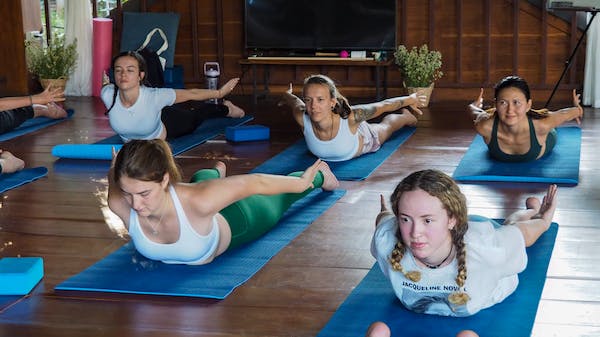
Dynamic exercises are pivotal in women’s fitness, offering a diverse approach to toning and strengthening the body. These exercises prove fundamental in achieving overall physical agility and strength through a combination of movements that engage multiple muscle groups. This article will delve into dynamic exercise benefits and intricacies for women.
What is the Role of Dynamic Exercises in Women’s Fitness?
Dynamic exercises encompass a range of movements that involve varying intensities and utilize multiple muscles simultaneously. They cater to the specific physiological needs of women, promoting functional strength, flexibility, and cardiovascular health. Dynamic Exercises empowers women through toning and strengthening their bodies.
Toning develops lean muscle and reduces body fat, producing a more refined physique. On the other hand, strengthening focuses on enhancing muscle power and endurance, contributing to overall physical resilience.
The Science Behind Women’s Fitness
Unveiling Muscle Composition
Muscle composition in women refers to the distribution and ratio of muscle tissue within their bodies. This term highlights the proportion of muscle mass compared to other bodily components like fat, bone, and connective tissue. Understanding muscle composition in women is crucial for assessing overall health, fitness levels, and specific dietary and exercise needs.
Differentiating muscle fibers reveals that women possess a combination of slow-twitch and fast-twitch muscle fibers. Understanding this composition helps tailor workouts for optimal performance and results.
Impact of Hormonal Variance on Muscle Development
Hormones play a crucial role in the development of muscle hypertrophy and strength. These chemical messengers travel throughout the body, regulating complex functions such as growth, metabolism, fertility, and the body’s response to physical stress. When the brain sends signals, hormones are released into the bloodstream and circulate until they reach their target cells. Once hormones bind to their targets, they initiate biological changes by altering protein synthesis.
Hormones facilitate communication between distant body parts, enabling coordinated changes directed by the brain. Hormone production during exercise can fluctuate due to overtraining, nutrition, and sleep, affecting the body’s ability to release the appropriate amount of hormones.
Hormones execute complex functions within the body. If conducted smartly, resistance training can optimize the beneficial effects of hormones. Yet, overtraining can result in severe muscle deterioration and performance impediments.
Hormones are crucial in preserving muscle mass and strength within your body. Decreasing muscle strength makes older adults more susceptible to falls or hesitant to engage in activities they once enjoyed. Hormonal fluctuations in women affect muscle development. For instance, estrogen levels influence fat distribution and can impact muscle recovery and growth. While many women understand that estrogen is essential for maintaining bone density, various studies affirm that adequate testosterone levels are vital for proper bone and muscle mass development, muscle strength, and bone density. Testosterone influences virtually every tissue in the body, including the distribution of fat.
Therefore, it’s unsurprising that as you age and your testosterone levels decline (with hormonal changes beginning as early as your 30s!), you may experience reduced muscle mass and strength, accompanied by an increase in body fat percentage, leading to a feeling of being “soft” around the midsection.
Commonly, people associate testosterone and estrogen solely with sexual function, perceiving testosterone as a “male” hormone and estrogen as “female.” However, both genders rely on a spectrum of endocrine glands—pituitary, adrenal, pineal, thymus, thyroid, pancreas, and testes/ovaries—that serve as the body’s hormone factory, generating, storing, and releasing hormones into the bloodstream to regulate vital organs. Beyond sexual function, estrogen (estradiol) holds significance for anti-aging benefits and disease prevention.
Hormones extend their influence beyond sexual realms, impacting tissue growth, metabolism, emotions, mood, reproduction, and more. While age commonly affects hormone levels, factors like stress, environmental toxins, and physical activity can disrupt hormonal balance. Given their profound impact on overall well-being, dysfunction within the endocrine system can yield numerous undesirable effects beyond muscle mass and strength loss.

Metabolic Variations in Women
Metabolism refers to converting food into calories, which our bodies utilize as fuel. Our metabolic rate indicates the number of calories our bodies burn in a typical day. When our calorie expenditure from activity surpasses our intake, we gradually lose weight, while weight gain over time occurs when we consume more calories than we burn.
Calories are expended through various means, including resting metabolism (or basal metabolic rate [BMR]), food digestion, and physical activity. Resting metabolism, crucial for vital functions such as blood circulation, respiration, temperature regulation, and cognitive processes, accounts for the highest daily calorie expenditure and often decelerates with age.
Research indicates that over time, metabolic rate, representing the speed at which we burn calories, gradually decreases by 2 to 3 percent per decade, commencing in our 20s. The decline becomes more apparent between the ages of 40 and 60. Although men and women experience this slowdown, it typically impacts women more due to their slower metabolism.
Insights into Basal Metabolic Rate (BMR) elucidate the calories burned at rest. Women often have a lower BMR than men, influencing energy expenditure and weight management.
Understanding Fat Distribution
Fat is stored within the body in distinct compartments, primarily in two main areas: subcutaneous, located beneath the skin, and visceral or abdominal, situated around the internal organs.
Men and women differ in their fat storage tendencies. Before menopause, women tend to store fat primarily in subcutaneous areas like the buttocks and thighs, whereas men are more predisposed to accumulating visceral (abdominal) fat. Following menopause, women also experience a heightened propensity for fat storage in the abdominal region.
Women store fat differently than men, with a higher tendency for subcutaneous fat. This impacts body shape and the approach to targeted exercises for fat loss.
Tailoring Exercises to Women’s Physiology
The Power of Compound Movements
Compound exercises involve activating multiple joints and muscle groups simultaneously, replicating natural movements commonly seen in everyday life. These exercises improve overall strength, enhance functional abilities, and promote calorie expenditure.
Adaptive Workouts for Women
Designing exercises tailored to meet the unique requirements of women entails emphasizing flexibility, mobility, and joint health. Programs that consider these aspects help prevent injuries and enhance overall well-being.
Dynamic Exercise Benefits for Women:
Dynamic Exercises for Cardiovascular Awakenings
During dynamic exercise, oxygen consumption is significantly boosted, primarily due to heightened heart rate and peripheral oxygen extraction and, to a lesser extent, increased stroke volume. Additionally, exercise leads to a slight rise in the average systemic and pulmonary artery pressures and a notable decrease in systemic and pulmonary resistances. These alterations in focal vasomotor tone result in a more significant proportion of the cardiac output being directed to the working muscles.
(HIIT)High-Intensity Interval Training (HIIT) consists of brief, vigorous exercise followed by short rest periods, enhancing cardiovascular health and calorie burning. Including aerobics in your routine enhances endurance and promotes heart health.
High-Intensity Interval Training (HIIT) comprises brief intervals of intense exercise followed by intervals of rest or low-intensity activity.
Dynamic Exercises for Strength in Motion
Muscular strength and endurance can be cultivated through both dynamic and static exercises. While each type has its uses, active exercises are typically recommended for most individuals. Dynamic strength exercises are best performed rhythmically, at a low to moderate speed, and across a full range of motion.
Contrary to common misconceptions, weight training doesn’t bulk women but contributes to lean muscle development, bone density, and metabolic rate. Bodyweight exercises offer a practical approach to building strength without requiring specialized equipment.
Dynamic Exercises for Mind-Body Harmony
Yoga and Pilates prioritize flexibility, core strength, and mental wellness. They offer a holistic approach to fitness, fostering mental clarity and physical balance.
Yoga, rooted in ancient India, is a comprehensive practice encompassing physical, mental, and spiritual aspects. Initially systematized by the sage Patanjali in his Yoga Sutras around 400 C.E., its transmission primarily occurred through direct teacher-to-student interactions before the emergence of this text. Despite its traditional one-to-one format, the popularity of yoga in the Western world during the 20th century led to the prevalence of group classes.
The term “yoga” stems from the Sanskrit root “yuj,” which translates to “to yoke” or “to unite,” reflecting its core aim of fostering harmony between body, mind, and spirit, as well as the connection between the individual self and universal consciousness. This integration often diminishes ego-driven thoughts and behaviors, facilitating spiritual awakening. While yoga has diverse interpretations and styles, its overarching goal remains the liberation from suffering, with most schools emphasizing the integration of body, mind, and breath to induce energetic shifts or altered consciousness.
Pilates, by definition, constitutes a system of repetitive exercises conducted on a yoga mat or specialized equipment to enhance strength, stability, and flexibility. It emphasizes muscular development from the core, fostering body awareness to facilitate efficient and graceful everyday movements. Initially popularized among dancers, Pilates has gained broader appeal across various demographics since its inception by Joseph Pilates in the 1920s. Advocates highlight its core-strengthening advantages for enhancing posture and balance, targeting key muscle groups such as the hips, glutes, pelvic floor, and lower back, often called the “powerhouse.” Emphasizing mindful breathing akin to yoga, Pilates finds applications in rehabilitation settings and among fitness enthusiasts and elite athletes.

Specific Dynamic Exercise Routines:
A Week of Empowering Workouts
- Monday: Engage in HIIT Workouts
- Tuesday: Dedicate time to Strength Training
- Wednesday: Practice Yoga or Pilates
- Thursday: Embrace Cardio Blast
- Friday: Incorporate Bodyweight Exercises
- Saturday: Allow for Active Recovery
- Sunday: Rest and Rejuvenate for Optimal Recovery
Nutritional Support for Dynamic Exercises:
Fueling the Body Right
Dynamic Exercises with balanced nutrition, including a mix of macronutrients (proteins, carbohydrates, and fats), is crucial for energy, muscle recovery, and overall performance. Maintaining adequate hydration is essential for sustaining energy levels and facilitating recovery.
The Role of Supplements
Understanding essential supplements for women, such as calcium for bone health or iron for energy, can complement a balanced diet. Selecting supplements tailored to individual needs is critical for optimizing performance.
Overcoming Challenges:
Addressing Time Constraints
Incorporating efficient workouts suitable for busy schedules ensures consistency in fitness routines. Strategies like time-blocking and maximizing intensity prove helpful.
Battling Plateaus
Diversifying workouts, intensities, and durations helps break through fitness plateaus. Adapting to evolving fitness levels is essential for continual progress.
Incorporating Mental Wellness:
The Mind-Body Connection
Mindfulness, meditation, and visualization techniques complement physical exercises, promoting mental clarity and focus.
Building a Supportive Environment
Creating a community or seeking guidance from mentors and fitness professionals fosters motivation, accountability, and a supportive environment for continued progress while doing dynamic exercises.
Dynamic Exercises’ Safety Measures and Precautions:
Injury Prevention Strategies
Incorporating warm-up and cool-down routines and being attuned to bodily signals during Dynamic Exercises are crucial in preventing workout-related injuries.
Seeking Professional Guidance
Consulting fitness trainers and healthcare specialists help understand individual limits and address underlying health conditions, ensuring safe and effective workout routines.
Conclusion:
Empowering the body through dynamic exercises tailored for women leads to a more muscular, more resilient physique. This continual evolution in women’s fitness enhances physical strength and fosters holistic well-being. Dive into these tailored exercises, infuse your routines with the science behind them, and embrace a journey toward a more empowered and healthier you.



